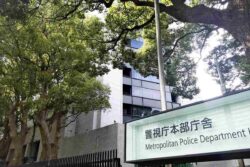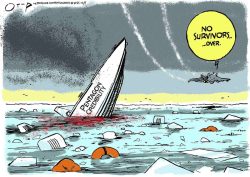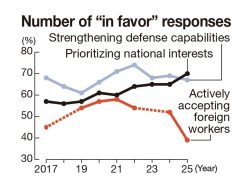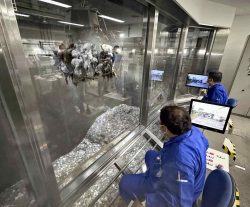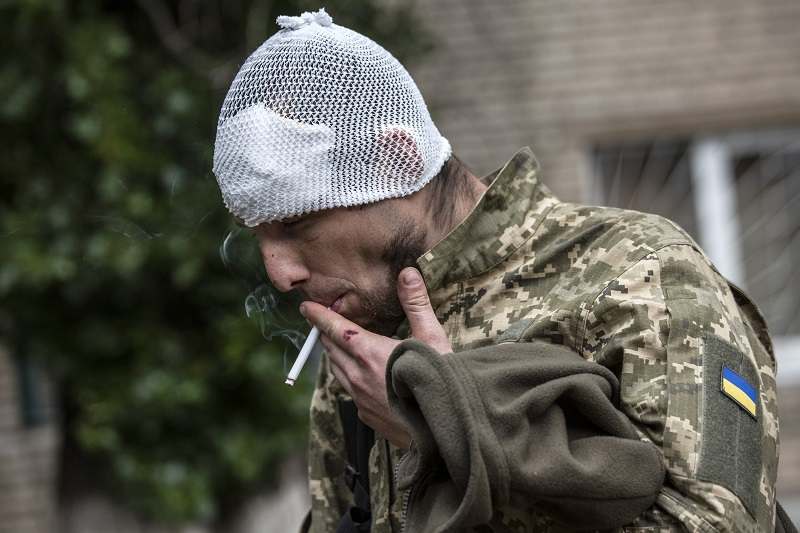
A Ukrainian soldier who was wounded by a mine in Severodonetsk smokes outside a hospital on Sunday.
12:38 JST, May 31, 2022
Shrapnel from an explosion has killed a French journalist who was covering evacuations in one of the last major Ukrainian-held areas of the country’s eastern Luhansk oblast, officials said Monday, the same day France’s foreign minister was visiting Ukraine.
Russian troops had been closing in on the city of Severodonetsk, where they’ve focused their efforts as they try to gain control of the Donbas region. Ukrainian President Volodymyr Zelensky said 90% of the city’s buildings and all of its “critical infrastructure” have been destroyed. Moscow is using air support for its assault, officials say.
Meanwhile, in Monday morning talks, E.U. ambassadors did not reach a deal to phase out imports of oil from Russia, amid ongoing opposition from Hungary, keeping the issue on the E.U.’s agenda – and Russian oil flowing.
President Joe Biden told reporters on Monday morning that the United States would not “send to Ukraine rocket systems that can strike into Russia.” It was not clear what that meant for long-range weapons that administration officials had been preparing to send.
Zelensky was set to address a special European Council summit scheduled for Monday and Tuesday.
There is heavy fighting between Russian and Ukrainian forces in the key eastern city of Severodonetsk, with the Russians using air support, Serhiy Haidai, the regional governor of Ukraine’s eastern Luhansk region, said Monday morning in a Telegram update.
“The enemy managed to enter Severodonetsk from two directions … and controls a strip of about 100 meters,” Roman Vlasenko, the head of the Severodonetsk district administration, told Radio Liberty. “Our guys are continuing to defend.” For the past several days, Ukrainian fighters had contained the Russians around a hotel on the eastern outskirts.
Russia is attempting to gain control of Donbas, which includes the regions of Donetsk and Luhansk. Severodonetsk is the largest city still holding out, and a Russian takeover there would be a major symbolic victory. About 100,000 people lived in the city before the war, but only about a tenth remain.
Russian shelling killed two people and wounded five others as they were preparing food outside Sunday in the old part of Severodonetsk, Haidai said. At least 12 buildings were hit there. He said the city’s critical infrastructure has been almost totally destroyed and 90 percent of the housing stock damaged.
“Over the past 24 hours, 14 enemy attacks have been repulsed, two artillery systems, 11 units of armored combat vehicles and 10 enemy vehicles have been destroyed. Air defense units shot down two cruise missiles and three Cube UAV,” Haidai said.
The neighboring city of Lysychansk, on the other side of the Siversky Donets River, is still in Ukrainian hands, according to Haidai, and main roads into both cities are still open but subject to Russian shelling. Humanitarian supplies are reaching the cities, he said. The highway from Bakhmut, further to the southwest, which is vital for resupplying Severodonetsk, remains under control of the Ukrainian military, said Vlasenko, but is very dangerous due to continual Russian shelling.
Severodonetsk “is littered with Russian corpses” as their forces advance in to the city, Haida said. “The streets are hot – this could lead to the development of infections in the future.”
He said three doctors had gone missing and only a damaged ambulance had been found.
For the past several days, Ukrainian fighters had contained the Russians around a hotel on the eastern outskirts of the city, but now there is heavy fighting in the streets, Haidai said earlier.
The Russian army “threw all the forces they had to surround Severodonetsk,” Vlasenko told Radio Liberty. “Today is the third or fourth day that the city is under fire 24/7, the logistics are very difficult.”
The “liberation” of Ukraine’s Donetsk and Luhansk regions is Moscow’s “absolute priority,” Russian Foreign Minister Sergei Lavrov said Sunday, but he denied that the Kremlin planned to annex the two eastern regions, which he described as “sovereign states.”
“Our obvious objective is, of course, to push the Ukrainian army and the Ukrainian battalions out of the Donetsk and Luhansk regions,” he said in an interview with French broadcaster TF1, claiming it would be up to the populations of these and other regions to decide their future.
U.S. officials warned early this month that Moscow could soon annex more Ukrainian territory, beginning with its occupied land in the east and possibly stretching south to Kherson. The planned annexations will include sham referendums, said Michael Carpenter, the U.S. ambassador to the Organization for Security and Cooperation in Europe.
Lavrov also described Western sanctions as “hysterical.” On a geopolitical level, he said, “the main loser in this story is Europe.”
The Russian-occupied Kherson region has started shipping grain to Russia, according to a pro-Moscow local official there.
The grain was from stores accumulated after last year’s harvest, Kirill Stremousov, deputy head of the military-civilian administration, told TASS news agency, adding that the Kherson authorities were also planning to send sunflower seeds for processing at Russian plants.
Ukraine has accused Russia of stealing grain in areas it controls since it invaded in February, exporting nearly 500,000 tons of grain from areas under its control, according to deputy agricultural minister Taras Vysotsky.
After the invasion, Kherson was the first major city to fall under Russian control. It is adjacent to Crimea, which Russia annexed in 2014.
There are plans to introduce the Russian ruble in Kherson, and on Saturday the area closed its borders to Ukrainian-held territory. U.S. intelligence has warned that Russia plans to annex Kherson and other areas under its control through rigged referendums.
Meanwhile, with Ukrainian ports blockaded by Russia, an estimated 28 million tons of grain cannot be exported, leading to rising prices internationally and fears of a global food crisis.
"News Services" POPULAR ARTICLE
-

Taiwan President Shows Support for Japan in China Dispute with Sushi Lunch
-

Japan Trying to Revive Wartime Militarism with Its Taiwan Comments, China’s Top Paper Says
-

Japan’s Nikkei Stock Average as JGB Yields, Yen Rise on Rate-Hike Bets
-

Japan’s Nikkei Stock Average Licks Wounds after Selloff Sparked by BOJ Hike Bets (UPDATE 1)
-

Japanese Bond Yields Zoom, Stocks Slide as Rate Hike Looms
JN ACCESS RANKING
-
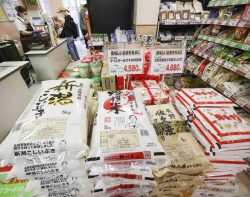
Govt Plans to Urge Municipalities to Help Residents Cope with Rising Prices
-

Japan Resumes Scallop Exports to China
-

Japan Prime Minister Takaichi Vows to Have Country Exit Deflation, Closely Monitor Economic Indicators
-

Japan to Charge Foreigners More for Residence Permits, Looking to Align with Western Countries
-

Japan GDP Down Annualized 1.8% in July-Sept.










